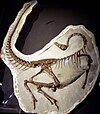User:Abyssal/DYK
Appearance
DYKs

- ... that the low numbers of injuries in carnivorous dinosaurs (Allosaurus pictured) indicate they may have been less aggressive with individuals of their own species than modern crocodilians?
- ... that the Hilda mega-bonebed is Canada's largest dinosaur bonebed, preserving thousands of the horned dinosaur Centrosaurus apertus across an area of 2.3 square kilometers (0.9 sq mi)?
- ... that the rough-scaled sea snake is highly venomous and every scale on its body is adorned with a spine?
- ... that multiple Leptocleidus skeletons have been found preserved as gemstone quality opal over the course of the history of plesiosaur research?
- ... that paleontologists have discovered the fossilized eggs of cephalopods, fishes, and reptiles, with some dinosaur eggs being preserved with pathological shell deformities?

- ... that within the United States, dinosaur fossils (example pictured) have been found in Alabama, Alaska, Arizona, Arkansas, California, Colorado, Connecticut, Delaware, Georgia, Idaho, Iowa, Kansas, Louisiana, Maryland, Massachusetts, Minnesota, Mississippi, Missouri, Montana, Nebraska, Nevada, New Jersey, New Mexico, New York, North Carolina, North Dakota, Oklahoma, Oregon, Pennsylvania, South Carolina, South Dakota, Tennessee, Texas, Utah, Virginia, Washington, D.C., and Wyoming, but not in Florida, Hawaii, Illinois, Indiana, Kentucky, Maine, Michigan, New Hampshire, Ohio, Rhode Island, Vermont, Washington, West Virginia, or Wisconsin?
- ... that highlights from the history of tyrannosaur research include the first carnivorous dinosaur known to walk bipedally, the giant Tyrannosaurus rex, and feathered taxa from China like Yutyrannus?
- ... that highlights from the history of dromaeosaurid research include a skeleton of Velociraptor preserved in combat with a Protoceratops, the gigantic Utahraptor, and tiny four-winged Microraptor?

- ... that within the United States, dinosaur fossils (example pictured) have been found in Alabama, Alaska, Arizona, Arkansas, California, Colorado, Connecticut, Delaware, Georgia, Idaho, Iowa, Kansas, Louisiana, Maryland, Massachusetts, Minnesota, Mississippi, Missouri, Montana, Nebraska, Nevada, New Jersey, New Mexico, New York, North Carolina, North Dakota, Oklahoma, Oregon, Pennsylvania, South Carolina, South Dakota, Tennessee, Texas, Utah, Virginia, Washington, D.C., and Wyoming, but not in Florida, Hawaii, Illinois, Indiana, Kentucky, Maine, Michigan, New Hampshire, Ohio, Rhode Island, Vermont, Washington, West Virginia, or Wisconsin?
- ... that highlights from the history of tyrannosaur research include the first carnivorous dinosaur known to walk bipedally, the giant Tyrannosaurus rex, and feathered taxa from China like Yutyrannus?
- ... that highlights from the history of dromaeosaurid research include a skeleton of Velociraptor preserved in combat with a Protoceratops, the gigantic Utahraptor, and tiny four-winged Microraptor?

- ... that highlights from the history of ornithomimosaur research include the ostrich-like Ornithomimus (skeletal mount pictured), an Archaeornithomimus bonebed in Mongolia, and the bizarre, giant-armed Deinocheirus?
- ... that highlights from 19th century ichnology include the discovery of protomammal tracks in England, dinosaur footprints in Massachusetts, and the mysterious hand-shaped Chirotherium tracks (pictured)?
- ... that during the 20th century, the first large-scale excavation of dinosaur footprints was undertaken in Texas for an exhibit at the American Museum of Natural History?
- ... that highlights from the history of ankylosaur research include one of the first dinosaurs ever discovered and a dinosaur with armored eyelids?
- ... that highlights from the history of ankylosaur research include one of the first dinosaurs ever discovered and a dinosaur with armored eyelids?

- ... that highlights from the history of troodontid research include the discovery that troodontids (example pictured) were among the brainiest dinosaurs?
- ... that oviraptorosaurs were thought to be egg-eaters after the discovery of Oviraptor on a nest of presumed Protoceratops eggs, until the nest was recognized as belonging to Oviraptor itself?
- ... that highlights from the history of coelophysoid research include a bone bed preserving thousands of Coelophysis in New Mexico, the large Gojirasaurus, and the Asian coelophysoid Panguraptor?
- ... that the hypothesis that the pachycephalosaurian dinosaurs used their domed skulls in head-butting competitions was first proposed in a work of science fiction?
- ... that over the course of the history of stegosaur research, their iconic back plates have been thought to function as armor plating, to regulate body temperature, or to attract mates?

- ... that major discoveries in the history of ceratosaur research include horned predators like Ceratosaurus (pictured), Majungasaurus, and Carnotaurus, as well as a bonebed of the projecting-toothed Masiakasaurus?
- ... that historical therizinosaur research misinterpreted these unusual bird-like herbivorous dinosaurs as giant turtles, semiaquatic fish-eaters, and tree-climbing insectivores?
- ... that highlights from the history of ichthyosaur research (example pictured) include fossils of pregnant females, whale-sized ichthyosaurs from Nevada, and ichthyosaurs with swordfish-like jaws?
- ... that highlights from the history of ceratopsian research include the discovery of the iconic Triceratops (skeletal mount pictured), spike-frilled Styracosaurus, and vast bonebeds preserving thousands of Centrosaurus?
- ... that highlights from the history of hadrosaur research include the first dinosaur fossils to be mounted in a museum, the colossal Shantungosaurus, and Maiasaura nesting grounds in Montana?
